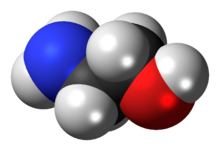Type: Toxin
Name: Ethanolamine (MEA, DEA, TEA)
RDA: 0
Importance- to Body:
Toxin: Respiratory, Skin, Eyes, Lungs
Distribution- in Body:
Skin, Respiratory System, Eyes
Excess Effects:
Allergic Reactions, Skin Irritation, Asthmatic Reactions, Cancer (still being further researched)
Deficiency Effects:
None Listed
Food Sources:
None Listed
Environmental/Geographic Sources:
Cosmetics, Blush, Eyeliner, Mascara, Eyeshadows, Foundations, Soaps, Ointments, Shampoos, Hair Dyes, Sunscreen, Cleaning products, Shaving products
Supplemental information:
Causes ‘suds’ in soaps and cleansers
Works Cited:
“Ethanolamine.” A History of Cosmetics from Ancient Times | Cosmetics Info, cosmeticsinfo.org/ingredient/ethanolamine

| |

| |
| Names | |
|---|---|
| Preferred IUPAC name
2-Aminoethan-1-ol | |
Other names
| |
| Identifiers | |
3D model (JSmol)
|
|
| ChEBI | |
| ChEMBL | |
| ChemSpider | |
| DrugBank | |
| ECHA InfoCard | 100.004.986 |
| EC Number | 205-483-3 |
| KEGG | |
PubChem CID
|
|
| RTECS number | KJ5775000 |
| UNII | |
| |
| |
| Properties | |
| C2H7NO | |
| Molar mass | 61.08 g·mol−1 |
| Appearance | Viscous colourless liquid |
| Odor | Unpleasant ammonia-like odour |
| Density | 1.0117 g/cm3 |
| Melting point | 10.3 °C (50.5 °F; 283.4 K) |
| Boiling point | 170 °C (338 °F; 443 K) |
| Miscible | |
| Vapor pressure | 64 Pa (20 °C) |
| Acidity (pKa) | 9.50 |
Refractive index (nD)
|
1.4539 (20 °C) |
| Hazards | |
| Safety data sheet | Sigma |
| GHS pictograms |  
|
| GHS signal word | Danger |
| H302, H312, H332, H314, H335, H412 | |
| P261, P273, P305+351+338, P303+361+353 | |
| NFPA 704 | |
| Flash point | 85 °C (185 °F; 358 K) (closed cup) |
| 410 °C (770 °F; 683 K) | |
| Explosive limits | 5.5–17% |
| Lethal dose or concentration (LD, LC): | |
LD50 (median dose)
|
|
| US health exposure limits (NIOSH): | |
PEL (Permissible)
|
TWA: 3 ppm (6 mg/m3) |
REL (Recommended)
|
|
IDLH (Immediate danger)
|
30 ppm |
| Related compounds | |
Related compounds
|
|
Except where otherwise noted, data are given for materials in their standard state (at 25 °C [77 °F], 100 kPa). | |
| Infobox references | |
Ethanolamine (2-aminoethanol, monoethanolamine, ETA, or MEA) is an organic chemical compound with the formula HOCH2CH2NH2. The molecule is both a primary amine and a primary alcohol (due to a hydroxyl group). Ethanolamine is a colorless, viscous liquid with an odor reminiscent to that of ammonia. Its derivatives are widespread in nature; e.g., lipids.
The ethanolamines comprise a group of amino alcohols. A class of antihistamines is identified as ethanolamines, which includes carbinoxamine, clemastine, dimenhydrinate, diphenhydramine, and doxylamine.


